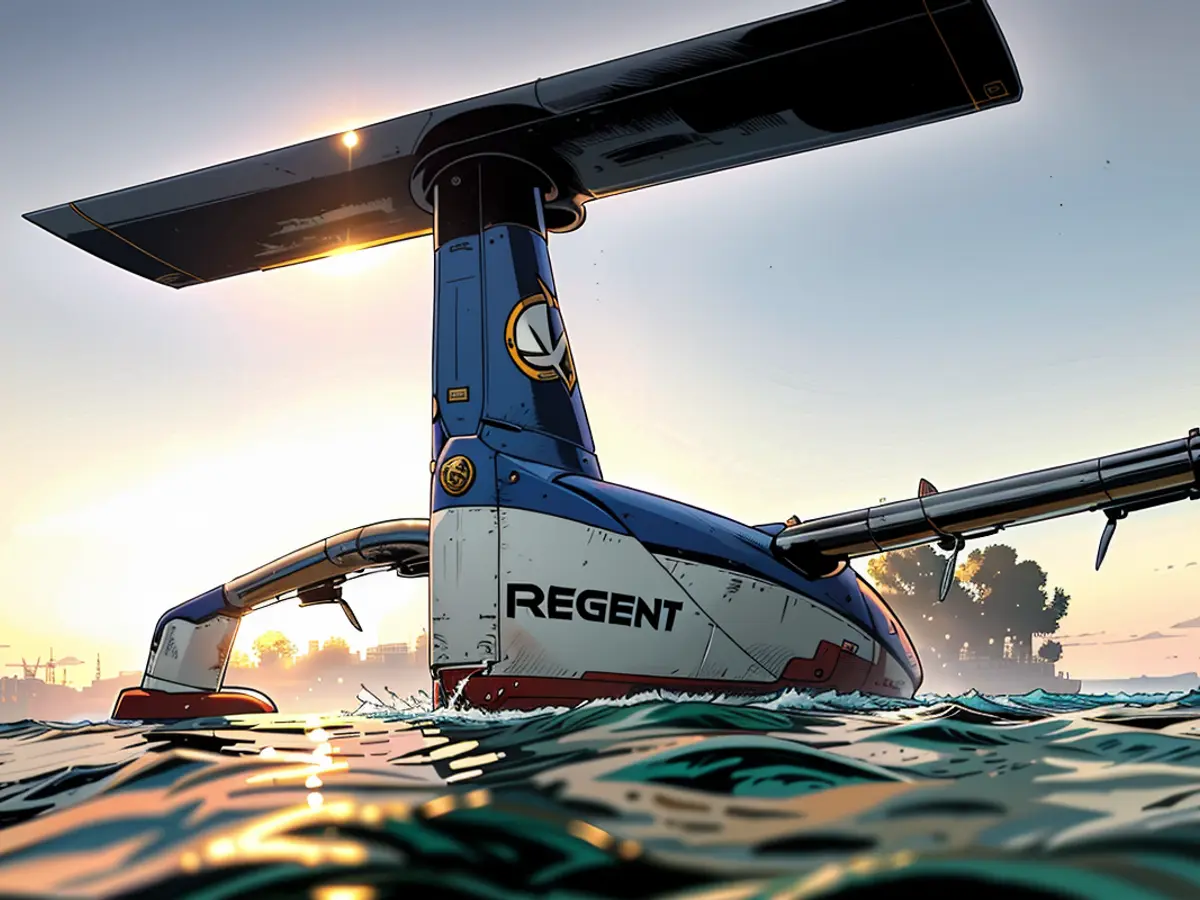Water-skimming "seagliders" may speed up maritime travel, potentially replacing ferries.
Get ready to experience the thrill of "floating, foiling, and flying" onboard a brand new seaglider, a fully electric boat-plane hybrid that could soon become a common sight in coastal communities around the world. This innovative technology is being developed by Boston-based startup REGENT.
Seagliders operate in three phases. Start off by "floating," much like a traditional boat. As it gains speed, the seaglider begins to "foil" - gliding over the water's surface using wing-like structures known as hydrofoils. Once it reaches the flying phase, it doesn't go sky-high, but only flies up to 30 feet (around 9 meters) above the water. This unique approach harnesses the power of a principle called "ground effect" which promises a smooth ride with lower drag compared to regular flying.
In 2023, Billy Thalheimer, co-founder and CEO of REGENT, plans to test out a full-scale 15,000-pound (6,800-kilogram) prototype with room for 12 passengers. These seagliders will have a range of approximately 180 miles (290 kilometers), making them a strong competitor against small ferries and seaplanes.
Over 600 seagliders have already been sold for a total of over $9 billion, with Thalheimer expecting that the first commercial seagliders will be manufactured in North America. They've even struck a deal with the government of Abu Dhabi to build a second seaglider production facility in the United Arab Emirates, serving clients in the region and across Europe and Asia.
Eventually, seagliders will connect Abu Dhabi to Dubai and bring improved transportation services to island communities that are underserved at the moment.
Thalheimer is excited, explaining, "We want to show the world that this is possible, and that you can have a vehicle that can float, foil, and fly."
An ancient idea
The principle of "ground effect" isn't entirely new. The Soviet Union explored it in the 1960s, resulting in massive planes called "ekranoplans" that could fly only a few feet above the water, ice, or land. One particularly infamous model was called "Caspian Sea Monster."
"The ground effect was being used by everyone who flies, but they didn't even realize it," says Thalheimer. "When you're approaching landing and your plane kind of floats a little before touching down, that's the ground effect."
Despite the United States and Germany studying ground effect vehicles, the concept never gained widespread adoption. But by combining "ground effect" with hydrofoils, REGENT has managed to create a modern and functional ground-effect vessel that can efficiently handle waves, maneuver through harbors, and operate safely even in crowded environments.

To make seagliders a reality, REGENT tackled a few key challenges. First, they had to improve wave tolerance. Old ground effect vehicles would often "skip" over the water surface and be either uncomfortable or completely inoperable during rough seas. They solved this issue with hydrofoils, allowing seagliders to tackle waves up to 5 feet (1.5 meters) tall.
Another challenge was maneuvering in harbor areas. Traditional ground effect vehicles lacked waterborne steering mechanisms, making them dangerous in busy harbors. The combination of hydrofoils and three distinct operation modes - "floating," "foiling," and "flying" - give seagliders the versatility to act like boats where necessary and transition smoothly into the flying phase on calm waters.
Lastly, they worked on passenger safety. Instead of relying on pilots to control the seagliders like they would with a typical aircraft, an advanced system of flight control sensors and software allows a human to focus on navigating, communicating, planning, and strategizing. As Thalheimer puts it, "We're leaving the flying to the vessel and just giving the captain control over boat movements."
The first customers to utilize seagliders will reportedly include Surf Air Mobility, a commuter airline. This company will employ seagliders to connect islands across Hawaii and along the coastlines of Miami, stretching from Key West to the Bahamas. In Europe, Brittany Ferries has expressed their interest in seagliders, aiming to link the United Kingdom and France across the English Channel. Thalheimer mentions that deals have also been established in the Mediterranean, enabling connections between the southern parts of France and Italy, as well as the Greek islands. Japan Airlines and Ocean Flyer are also expected to be among the initial operators.
The seagliders are hoped to improve transportation in Abu Dhabi, as they can potentially address existing bottlenecks in public transport. According to Thalheimer, the Department of Transportation in Abu Dhabi is seeking to boost connectivity to more remote emirates such as Ras Al Khaimah and underserved island communities within the Gulf, including Dalma Island. He suggests that this approach could be applied in different island regions around the globe.
Viceroy is expected to be followed by a larger seaglider, known as Monarch, which could carry up to 100 passengers. Thalheimer estimates that Monarch will be operational by the end of the current decade. However, he also adds that significant advancements in battery technology would be necessary to sustain this vehicle's projected range of 300 to 500 miles. Darren Biddlecombe, the head of data at aviation consultancy firm AviationValues, acknowledges the potential of REGENT's plan if they can overcome the regulatory, commercial, and financial obstacles.
Biddlecombe points out that successful implementation of seagliders will hinge on REGENT's abilities to bring the necessary capital and expertise into their operation. This will involve addressing regulatory approval, providing ample training, establishing infrastructure, obtaining parts and maintenance support, and ensuring reliability and affordability for passengers. The success of the seaglider project will rely heavily on REGENT's ability to navigate these challenges.
Despite these complexities, Biddlecombe considers seagliders an enticing development given their potential as a convenient and ecologically friendly mode of travel. However, the success of this ambitious project will ultimately be determined by REGENT's capability to manufacture and support these vessels, ensuring that they can be used safely and affordably by operators and passengers alike.

Read also:
Engaging in travel could potentially offer the opportunity to experience this revolutionary technology firsthand, as seagliders may become a common mode of transportation in coastal communities.
The advancements in seaglider technology could revolutionize maritime travel, potentially making ferry trips a thing of the past.
- Fear of escalation in the Middle East: US Secretary of State Blinken travels to the region again
- Government circles: US Secretary of State Blinken to travel to Middle East again
- Bridging days 2024: How you can double your vacation this year
- Germany has wanderlust: how tour operators and airlines are looking ahead to the next travel year








